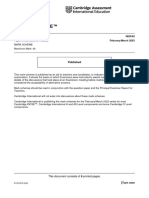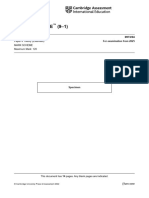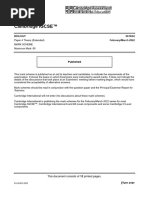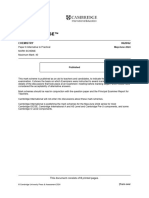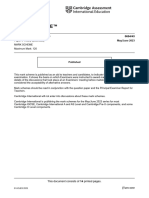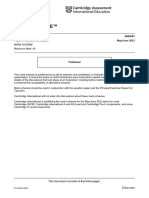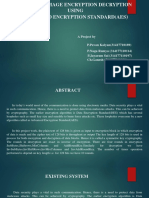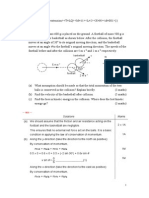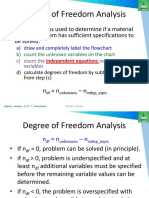Cambridge IGCSE ™: Combined Science
Cambridge IGCSE ™: Combined Science
Uploaded by
jesslynaureliaCopyright:
Available Formats
Cambridge IGCSE ™: Combined Science
Cambridge IGCSE ™: Combined Science
Uploaded by
jesslynaureliaOriginal Title
Copyright
Available Formats
Share this document
Did you find this document useful?
Is this content inappropriate?
Copyright:
Available Formats
Cambridge IGCSE ™: Combined Science
Cambridge IGCSE ™: Combined Science
Uploaded by
jesslynaureliaCopyright:
Available Formats
Cambridge IGCSE™
COMBINED SCIENCE 0653/62
Paper 6 Alternative to Practical February/March 2023
MARK SCHEME
Maximum Mark: 40
Published
This mark scheme is published as an aid to teachers and candidates, to indicate the requirements of the
examination. It shows the basis on which Examiners were instructed to award marks. It does not indicate the
details of the discussions that took place at an Examiners’ meeting before marking began, which would have
considered the acceptability of alternative answers.
Mark schemes should be read in conjunction with the question paper and the Principal Examiner Report for
Teachers.
Cambridge International will not enter into discussions about these mark schemes.
Cambridge International is publishing the mark schemes for the February/March 2023 series for most
Cambridge IGCSE™, Cambridge International A and AS Level components and some Cambridge O Level
components.
This document consists of 7 printed pages.
© UCLES 2023 [Turn over
0653/62 Cambridge IGCSE – Mark Scheme February/March 2023
PUBLISHED
Generic Marking Principles
These general marking principles must be applied by all examiners when marking candidate answers. They should be applied alongside the
specific content of the mark scheme or generic level descriptors for a question. Each question paper and mark scheme will also comply with these
marking principles.
GENERIC MARKING PRINCIPLE 1:
Marks must be awarded in line with:
• the specific content of the mark scheme or the generic level descriptors for the question
• the specific skills defined in the mark scheme or in the generic level descriptors for the question
• the standard of response required by a candidate as exemplified by the standardisation scripts.
GENERIC MARKING PRINCIPLE 2:
Marks awarded are always whole marks (not half marks, or other fractions).
GENERIC MARKING PRINCIPLE 3:
Marks must be awarded positively:
• marks are awarded for correct/valid answers, as defined in the mark scheme. However, credit is given for valid answers which go beyond the
scope of the syllabus and mark scheme, referring to your Team Leader as appropriate
• marks are awarded when candidates clearly demonstrate what they know and can do
• marks are not deducted for errors
• marks are not deducted for omissions
• answers should only be judged on the quality of spelling, punctuation and grammar when these features are specifically assessed by the
question as indicated by the mark scheme. The meaning, however, should be unambiguous.
GENERIC MARKING PRINCIPLE 4:
Rules must be applied consistently, e.g. in situations where candidates have not followed instructions or in the application of generic level
descriptors.
© UCLES 2023 Page 2 of 7
0653/62 Cambridge IGCSE – Mark Scheme February/March 2023
PUBLISHED
GENERIC MARKING PRINCIPLE 5:
Marks should be awarded using the full range of marks defined in the mark scheme for the question (however; the use of the full mark range may
be limited according to the quality of the candidate responses seen).
GENERIC MARKING PRINCIPLE 6:
Marks awarded are based solely on the requirements as defined in the mark scheme. Marks should not be awarded with grade thresholds or
grade descriptors in mind.
Science-Specific Marking Principles
1 Examiners should consider the context and scientific use of any keywords when awarding marks. Although keywords may be present, marks
should not be awarded if the keywords are used incorrectly.
2 The examiner should not choose between contradictory statements given in the same question part, and credit should not be awarded for any
correct statement that is contradicted within the same question part. Wrong science that is irrelevant to the question should be ignored.
3 Although spellings do not have to be correct, spellings of syllabus terms must allow for clear and unambiguous separation from other syllabus
terms with which they may be confused (e.g. ethane / ethene, glucagon / glycogen, refraction / reflection).
4 The error carried forward (ecf) principle should be applied, where appropriate. If an incorrect answer is subsequently used in a scientifically
correct way, the candidate should be awarded these subsequent marking points. Further guidance will be included in the mark scheme where
necessary and any exceptions to this general principle will be noted.
5 ‘List rule’ guidance
For questions that require n responses (e.g. State two reasons …):
• The response should be read as continuous prose, even when numbered answer spaces are provided.
• Any response marked ignore in the mark scheme should not count towards n.
• Incorrect responses should not be awarded credit but will still count towards n.
• Read the entire response to check for any responses that contradict those that would otherwise be credited. Credit should not be
awarded for any responses that are contradicted within the rest of the response. Where two responses contradict one another, this should
be treated as a single incorrect response.
• Non-contradictory responses after the first n responses may be ignored even if they include incorrect science.
© UCLES 2023 Page 3 of 7
0653/62 Cambridge IGCSE – Mark Scheme February/March 2023
PUBLISHED
6 Calculation specific guidance
Correct answers to calculations should be given full credit even if there is no working or incorrect working, unless the question states ‘show
your working’.
For questions in which the number of significant figures required is not stated, credit should be awarded for correct answers when rounded by
the examiner to the number of significant figures given in the mark scheme. This may not apply to measured values.
For answers given in standard form (e.g. a 10n) in which the convention of restricting the value of the coefficient (a) to a value between 1
and 10 is not followed, credit may still be awarded if the answer can be converted to the answer given in the mark scheme.
Unless a separate mark is given for a unit, a missing or incorrect unit will normally mean that the final calculation mark is not awarded.
Exceptions to this general principle will be noted in the mark scheme.
7 Guidance for chemical equations
Multiples / fractions of coefficients used in chemical equations are acceptable unless stated otherwise in the mark scheme.
State symbols given in an equation should be ignored unless asked for in the question or stated otherwise in the mark scheme.
© UCLES 2023 Page 4 of 7
0653/62 Cambridge IGCSE – Mark Scheme February/March 2023
PUBLISHED
Question Answer Marks
1(a)(i) all results recorded ; 3
number score used instead of, words / descriptions ;
correct values assigned ;
1(a)(ii) higher concentration of acid gives higher clotting score / ORA ; 1
1(a)(iii) the higher the concentration of acid the more the protein has changed shape ; 1
1(a)(iv) temperature recorded as 24.5 (°C) ; 1
1(a)(v) not a source of error because 1
all test-tubes exposed to same temperature ;
1(a)(vi) idea that time in water bath not controlled / clotting score is subjective / insufficient mixing ; 1
1(b)(i) 67 / 66.7% ; 1
1(b)(ii) (yes because ….) 1
both show same trend / results (in Table 4.1) show more, solid / clotting when more acid is added ;
1(c)(i) 47 (mm) ; 1
1(c)(ii) 47 ÷ 15 000 ; 2
0.0031 / 3.1 10–3 (mm) ;
Question Answer Marks
2(a)(i) 21.0 ; 1
2(a)(ii) y-axis labelled temperature in °C AND x-axis labelled (total) volume (of acid added) in cm3 ; 3
suitable linear scales so that points occupy at least half of the grid ;
plots correct ½ small square ;
© UCLES 2023 Page 5 of 7
0653/62 Cambridge IGCSE – Mark Scheme February/March 2023
PUBLISHED
Question Answer Marks
2(a)(iii) best fit curve drawn ; 1
2(a)(iv) as the volume of acid increases the temperature increases ; 2
and (after increase) then decreases ;
2(a)(v) to ensure an even temperature ; 1
2(a)(vi) less thermal energy lost between experiments / less cooling / do not need to keep refilling burette ; 1
2(a)(vii) use a plastic beaker / use a polystyrene cup / wrap beaker with insulation ; 1
2(b)(i) iron(II) ; 1
2(b)(ii) it is a qualitative test not a quantitative test / only depends on the observation not any numerical values ; 1
2(b)(iii) blue precipitate / ppt ; 1
Question Answer Marks
3(a) keep your eyes level with the, point being measured / top of the spring / avoid parallax / look perpendicular to the, point 1
behind measured / top of the spring / fiducial aid / keep ruler as close as possible to the spring ;
3(b)(i) 43 1 ; 1
3(b)(ii) 20 ; 1
3(b)(iii) 0.03 ; 1
3(c) anomalous value = 0.05 ; 2
reason: other values are all 0.03 / is different from the other k values ;
3(d) measure as load is both added and removed, to check that l is the same / check spring has not stretched / repeat the 1
measurement and see if it is the, same / similar / close to original ;
© UCLES 2023 Page 6 of 7
0653/62 Cambridge IGCSE – Mark Scheme February/March 2023
PUBLISHED
Question Answer Marks
4 One mark from each section and any two other marking points: 7
additional apparatus:
(Max two from this section)
measuring cylinder / balance ;
stop-watch ;
thermometer ;
method and measurements:
measure volume / mass of liquid before starting / states a volume or mass for the liquid ;
measure temperature of liquid before starting and after heating ;
heat the liquid for a fixed time and measure temperature (increase) / heat the liquid for a fixed temperature increase and
measure the time taken ;
control variables:
use constant mass or volume of each liquid ;
voltage and / or current of heater ;
use the same initial temperature of liquid ;
table of results:
table shown with four liquids and columns for voltage, current, temperature and / or time (depending on their method) ;
with units for each column shown ;
conclusion:
describes how to calculate energy transferred for each liquid ;
compare the results in the table to see which is greatest ;
repeat to, identify anomalies / increase confidence (take average) ;
© UCLES 2023 Page 7 of 7
You might also like
- Cambridge O Level: Biology 5090/42Document9 pagesCambridge O Level: Biology 5090/42afsheen24akramNo ratings yet
- Phy - 122 DAE (1st Year)Document5 pagesPhy - 122 DAE (1st Year)Asim Aslam50% (6)
- FREE FE Practice ProblemsDocument50 pagesFREE FE Practice Problemsrezi100% (2)
- Villa Savoye Le CorbusierDocument25 pagesVilla Savoye Le CorbusierPaul HartlandNo ratings yet
- Cambridge IGCSE ™: BiologyDocument12 pagesCambridge IGCSE ™: BiologyTom TommmaNo ratings yet
- Cambridge IGCSE ™: BiologyDocument12 pagesCambridge IGCSE ™: BiologyAhmed TarekNo ratings yet
- Cambridge IGCSE ™: BiologyDocument7 pagesCambridge IGCSE ™: BiologyTom TommmaNo ratings yet
- Cambridge IGCSE ™: BiologyDocument10 pagesCambridge IGCSE ™: BiologyTom TommmaNo ratings yet
- Cambridge IGCSE™: Combined Science 0653/52 May/June 2021Document7 pagesCambridge IGCSE™: Combined Science 0653/52 May/June 2021Samson RamusNo ratings yet
- 0653_m23_ms_62Document7 pages0653_m23_ms_62farah.abed07No ratings yet
- Cambridge IGCSE™: Biology 0610/63Document8 pagesCambridge IGCSE™: Biology 0610/63manar mohamedNo ratings yet
- Cambridge IGCSE™: Biology 0610/53Document8 pagesCambridge IGCSE™: Biology 0610/53pro.is.only.me.cause.i.am.vrindaNo ratings yet
- Cambridge O Level: Physics 5054/41Document9 pagesCambridge O Level: Physics 5054/41Owein FernandoNo ratings yet
- Cambridge International AS & A Level: Biology 9700/34Document7 pagesCambridge International AS & A Level: Biology 9700/34mariakhan.educationNo ratings yet
- Cambridge O Level: Physics 5054/42Document7 pagesCambridge O Level: Physics 5054/42nexusdrops1No ratings yet
- Cambridge IGCSE ™: Co-Ordinated SciencesDocument14 pagesCambridge IGCSE ™: Co-Ordinated SciencesKhoa DangNo ratings yet
- Biology March Mark Scheme Paper 6Document7 pagesBiology March Mark Scheme Paper 6Muhammad ZiaNo ratings yet
- Cambridge IGCSE ™: Biology 0610/41Document12 pagesCambridge IGCSE ™: Biology 0610/41shabanaNo ratings yet
- paper 32 msDocument10 pagespaper 32 msdhritikapadia747No ratings yet
- Cambridge International AS & A Level: Biology 9700/31Document7 pagesCambridge International AS & A Level: Biology 9700/31LongNo ratings yet
- Cambridge IGCSE™: Combined Science 0653/62Document8 pagesCambridge IGCSE™: Combined Science 0653/62arindams.soodNo ratings yet
- Cambridge IGCSE™: Biology 0610/62 May/June 2022Document8 pagesCambridge IGCSE™: Biology 0610/62 May/June 2022walsha khanNo ratings yet
- Cambridge International AS & A Level: BiologyDocument7 pagesCambridge International AS & A Level: BiologyLongNo ratings yet
- Cambridge O Level: Physics 5054/42Document9 pagesCambridge O Level: Physics 5054/42Rithika HimathNo ratings yet
- IGCSE Combined Science Oct-Nov 2023 Ms - 62Document8 pagesIGCSE Combined Science Oct-Nov 2023 Ms - 62Kwee Siew KongNo ratings yet
- 0610 w23 Ms 52pracigcseDocument8 pages0610 w23 Ms 52pracigcsedesrescottNo ratings yet
- Cambridge IGCSE ™: Biology 0610/63 October/November 2022Document8 pagesCambridge IGCSE ™: Biology 0610/63 October/November 2022ramloghun veerNo ratings yet
- Mark SchemeDocument10 pagesMark Scheme12310-214No ratings yet
- Cambridge IGCSE ™: Physics 0625/63Document8 pagesCambridge IGCSE ™: Physics 0625/63Aarush GoskulaNo ratings yet
- Cambridge International AS & A Level: Biology 9700/32Document9 pagesCambridge International AS & A Level: Biology 9700/32LongNo ratings yet
- 0620 m23 Ms 62 PDFDocument8 pages0620 m23 Ms 62 PDF4yqyt65q8xNo ratings yet
- Cambridge IGCSE™ (9-1) : BIOLOGY (9-1) 0970/61 May/June 2021Document8 pagesCambridge IGCSE™ (9-1) : BIOLOGY (9-1) 0970/61 May/June 2021preet patelNo ratings yet
- Ans Paper 6Document7 pagesAns Paper 6suhaankochhar2008No ratings yet
- Cambridge IGCSE™: Combined Science 0653/31 May/June 2022Document11 pagesCambridge IGCSE™: Combined Science 0653/31 May/June 2022Thelma MusvotaNo ratings yet
- Cambridge O Level: Physics 5054/32Document9 pagesCambridge O Level: Physics 5054/32Syed Tanveer MahtabNo ratings yet
- Cambridge IGCSE ™: PhysicsDocument8 pagesCambridge IGCSE ™: Physicsadnanrameen.1098No ratings yet
- Cambridge IGCSE ™: Co-Ordinated Sciences 0654/41Document15 pagesCambridge IGCSE ™: Co-Ordinated Sciences 0654/41Khoa DangNo ratings yet
- 2025 Specimen Paper 4 Mark SchemeDocument14 pages2025 Specimen Paper 4 Mark SchemeIsnaini Rohayati, M.Pd.No ratings yet
- 0610 m22 Ms 42 PDFDocument12 pages0610 m22 Ms 42 PDFdavin tejaNo ratings yet
- Cambridge IGCSE™: Combined Science 0653/62 March 2020Document8 pagesCambridge IGCSE™: Combined Science 0653/62 March 2020Hin Wa LeungNo ratings yet
- Cambridge IGCSE™: Chemistry 0620/43Document11 pagesCambridge IGCSE™: Chemistry 0620/43krishaNo ratings yet
- Cambridge International AS & A Level: Biology 9700/34 October/November 2021Document8 pagesCambridge International AS & A Level: Biology 9700/34 October/November 2021lllllisaNo ratings yet
- Screenshot 2024-10-03 at 4.18.20 PMDocument8 pagesScreenshot 2024-10-03 at 4.18.20 PMKhurram AwanNo ratings yet
- November 2020 Mark Scheme Paper 51Document8 pagesNovember 2020 Mark Scheme Paper 51SULTAN SURGANo ratings yet
- AP4 AnsDocument8 pagesAP4 AnsPaco MattioNo ratings yet
- Cambridge O Level: Biology 5090/61 May/June 2021Document7 pagesCambridge O Level: Biology 5090/61 May/June 2021Sasaki MeraNo ratings yet
- Cambridge O Level: Chemistry 5070/32 October/November 2022Document7 pagesCambridge O Level: Chemistry 5070/32 October/November 2022Ankit MistryNo ratings yet
- Cambridge O Level: Physics 5054/42Document8 pagesCambridge O Level: Physics 5054/42breshnaimran321No ratings yet
- Cambridge IGCSE™: Biology 0610/42 February/March 2022Document12 pagesCambridge IGCSE™: Biology 0610/42 February/March 2022bali yunNo ratings yet
- Cambridge International AS & A Level: Biology 9700/33Document7 pagesCambridge International AS & A Level: Biology 9700/33LongNo ratings yet
- 0610 m22 Ms 32 PDFDocument11 pages0610 m22 Ms 32 PDFsolihinNo ratings yet
- Cambridge O Level: Chemistry 5070/42 May/June 2022Document9 pagesCambridge O Level: Chemistry 5070/42 May/June 2022Saeed RehmanNo ratings yet
- Cambridge IGCSE ™: Co-Ordinated Sciences 0654/42 October/November 2022Document13 pagesCambridge IGCSE ™: Co-Ordinated Sciences 0654/42 October/November 2022xuanquynhle03.95No ratings yet
- Cambridge IGCSE ™: Combined Science 0653/42 October/November 2022Document12 pagesCambridge IGCSE ™: Combined Science 0653/42 October/November 2022kavya pNo ratings yet
- Cambridge International AS & A Level: Biology 9700/43 May/June 2022Document23 pagesCambridge International AS & A Level: Biology 9700/43 May/June 2022Aneeqa KhanNo ratings yet
- Cambridge International AS & A Level: Biology 9700/33 October/November 2022Document6 pagesCambridge International AS & A Level: Biology 9700/33 October/November 2022mariakhan.educationNo ratings yet
- Cambridge International AS & A Level: Biology 9700/33 October/November 2021Document8 pagesCambridge International AS & A Level: Biology 9700/33 October/November 2021lllllisaNo ratings yet
- 0610 Paper 4 2022-24 MsDocument225 pages0610 Paper 4 2022-24 MsfocusedstudyingurlsNo ratings yet
- Cambridge IGCSE™: Physical Science 0652/61 October/November 2021Document7 pagesCambridge IGCSE™: Physical Science 0652/61 October/November 2021kadija2051No ratings yet
- 0610 w23 Ms 31IGCSEDocument12 pages0610 w23 Ms 31IGCSEdesrescottNo ratings yet
- Cambridge IGCSE™: Co-Ordinated Sciences 0654/43Document14 pagesCambridge IGCSE™: Co-Ordinated Sciences 0654/43Man Hol KwanNo ratings yet
- Cambridge IGCSE™: Chemistry 0620/61Document8 pagesCambridge IGCSE™: Chemistry 0620/61sovow33568No ratings yet
- VMWARE Certified Spring Professional Certification Cased Based Practice Questions - Latest EditionFrom EverandVMWARE Certified Spring Professional Certification Cased Based Practice Questions - Latest EditionNo ratings yet
- CICIND Model Code For Concrete Chimneys Part A The Shell SecondDocument23 pagesCICIND Model Code For Concrete Chimneys Part A The Shell SecondFreddy MillenNo ratings yet
- Text Encryption and DecryptionDocument17 pagesText Encryption and DecryptionJayaramsai PanchakarlaNo ratings yet
- Chapter 4 (Cont.) : Real Number RepresentationsDocument18 pagesChapter 4 (Cont.) : Real Number Representationshassan IQNo ratings yet
- Introduction To Set Theory: Mr. Sanjay ShuklaDocument90 pagesIntroduction To Set Theory: Mr. Sanjay ShuklaUltramicNo ratings yet
- Application of The Normal DistributionDocument8 pagesApplication of The Normal DistributionElisa LandinginNo ratings yet
- Chapter 1 Business Research 1Document32 pagesChapter 1 Business Research 1Klent Ace AxylNo ratings yet
- The Transfer Function The Transfer FunctionDocument7 pagesThe Transfer Function The Transfer FunctionTamires MarianeNo ratings yet
- Module 7Document3 pagesModule 7BawbityNo ratings yet
- 2009 - Ooi - Finite Element Prediction of Progressively Formed Conical StockpilesDocument13 pages2009 - Ooi - Finite Element Prediction of Progressively Formed Conical StockpilesNiko AlvaradoNo ratings yet
- 2 ch05 LQ eDocument19 pages2 ch05 LQ eCHANNo ratings yet
- GEC 104 Quiz On Modules 3 & 4 2021Document4 pagesGEC 104 Quiz On Modules 3 & 4 2021Ching DialomaNo ratings yet
- RS Aggarwal Solutions Class 12 Maths Chapter 1 Relations Exercise 1ADocument6 pagesRS Aggarwal Solutions Class 12 Maths Chapter 1 Relations Exercise 1ATanisha SinhaNo ratings yet
- Schedule Lecturer Semester 2 2021Document6 pagesSchedule Lecturer Semester 2 2021Fauzan nur SyahalamNo ratings yet
- Lecture 8 - Example Sequence Networks and Asymmetric FaultsDocument2 pagesLecture 8 - Example Sequence Networks and Asymmetric Faults12onn1eNo ratings yet
- Book 18 - Limits and DerivativesDocument13 pagesBook 18 - Limits and Derivativessudhir_kumar_33No ratings yet
- 2precal SLM Q4W1 2Document27 pages2precal SLM Q4W1 2Albert AroboNo ratings yet
- Texas Essential Knowledge and Skills For Grade 1Document36 pagesTexas Essential Knowledge and Skills For Grade 1Nokie TunayNo ratings yet
- Unitary Method Details MCQ and SolutionDocument21 pagesUnitary Method Details MCQ and SolutionLeo V. BakerNo ratings yet
- Lecture 2 MB and Degrees of Freedom CalculationsDocument33 pagesLecture 2 MB and Degrees of Freedom CalculationsMuhammad IchsanNo ratings yet
- Exam Practice 2 MSDocument8 pagesExam Practice 2 MSKezia TjandraNo ratings yet
- Principle of Virtual Work and D'Alembert's PrincipleDocument10 pagesPrinciple of Virtual Work and D'Alembert's PrincipleKristine Rodriguez-CarnicerNo ratings yet
- 6MathematicsSyllabiCompendium PDFDocument170 pages6MathematicsSyllabiCompendium PDFMark Jether GasmenNo ratings yet
- Numerais Indo EuropeuDocument18 pagesNumerais Indo EuropeuLéxico E DicionáriosNo ratings yet
- Search The Community Search SAP: Login RegisterDocument48 pagesSearch The Community Search SAP: Login RegisterAnil KumarNo ratings yet
- Decision Theory - Operations ResearchDocument18 pagesDecision Theory - Operations ResearchPriyanka ShetyeNo ratings yet
- AssignmentDocument7 pagesAssignmentMona VimlaNo ratings yet






























